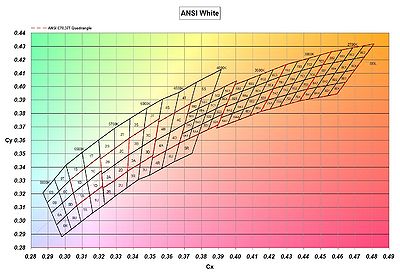ANSI White
This is a standard developed by the American National Standards Institute (ANSI) and the National Electrical Manufacturers Association (NEMA) in 2008 to standardize the description of tints in LED's and Solid State Lighting. It sets up 8 regions based on correlated color temperature (CCT) with centers at certain coordinates and offsets from the center that describe a "rectangle" on the chromaticity chart.
- 6500K
- 5700K (cool white)
- 5000K
- 4500K
- 4000K (neutral)
- 3500K
- 3000K (warm white)
- 2700K
This standard was adopted by companies like Cree and Philips Lumileds to describe the tint of their LED products. They divided each ANSI rectangle into 4 quadrants to get bins like 1A, 1B, 1C, and 1D being part of rectangle 1 (6500K). Tints lying outside of the ANSI standard above and below the rectangle are given names like 1R, 1S, 1T, and 1U. Towards the cold end of the spectrum a non-ANSI region, region 0, was added. Cree subdivides regions 5, 6, 7, and 8 into even smaller subdivisions to get bins like 5A1, 5A2, 5A3, and 5A4, while Lumileds would call all of those 5A.
Further Reading
- NEMA website ANSI standard can be downloaded after registering for free.
- Wikipedia: Chromaticity
- Wikipedia: Color temperature
